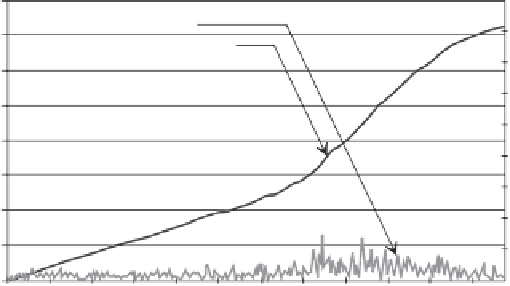Environmental Engineering Reference
In-Depth Information
PDE that describes the seepage and water storage processes.
The soil properties that produce nonlinearity in the moisture
flow PDEs are the permeability function and the water stor-
age function. Both of these soil properties are related to
the SWCC.
If the SWCC has a relatively high air-entry value and if
the rate of desaturation of the soil is relatively slow, then
there are usually few difficulties associated with conver-
gence of the moisture flow PDE. On the other hand, if the
air-entry value is low (e.g., less than 10 kPa), or extremely
low (e.g., less than 1.0 kPa), then convergence difficulties
can be encountered with some software packages. The rate
of desaturation also affects the nonlinearity of the PDE solu-
tion. There can be considerable difficulties encountered in
obtaining a converged solution if the rate of desaturation
defined by the SWCC is steep.
There is also the possibility that the solution may have
converged but the computer code has made compromising
assumptions to assist in the convergence. It is possible that
these assumptions will result in convergence to the wrong
answer. However, there are special computational techniques
that should be used when dealing with highly nonlinear
PDEs. The technique is referred to as adaptive grid refinement
(AGR) and can be applied to the finite element method.
The criterion to ensure convergence is similar to the
criteria imposed when solving finite difference numerical
solutions using longhand calculations. The time-and-space
relationship for the numerical solution must meet certain
criteria in order to ensure convergence. The convergence
criteria for a finite difference calculation are defined in terms
of a
β
value which must be less than 0.5. The convergence
criteria can be achieved by changing either the spatial
distance between nodes or the time step. When solving a
highly nonlinear, multidimensional finite element solution,
it is necessary to make changes to the time steps and/or
the size of the elements in order to ensure convergence
to the correct solution. These changes in the finite element
mesh must be performed in a dynamic manner that may
not even be observable to the modeller.
6.4.4 Initial Conditions to Start Analysis
It is necessary to have a procedure for starting a nonlin-
ear analysis. In other words, it is necessary to define the
initial conditions for commencing the analysis. Some pos-
sible procedures for commencing a nonlinear analysis are
suggested.
One of the procedures that can be used to establish ini-
tial conditions is to create a situation that simulates average
conditions over the past several years. The intent in this
case is to create a fictitious long-term steady-state situa-
tion. There are a number of ways a near steady state can be
achieved. One procedure involves averaging the precipita-
tion and weather conditions over a period of several years.
For example, average conditions can be calculated over a
10-year period if weather records are available.
Figure 6.57 shows the average precipitation conditions
calculated from a 10-year record of weather conditions. The
total precipitation for the year is also equal to the average
precipitation over the 10-year period. The average condi-
tions can be input into a preliminary infiltration model along
with an arbitrary set of initial conditions for other variables.
Calculations can be performed over a number of years until
the suction profile at the end of back-to-back years remains
the same.
It often takes between 2 and 4 years of simulation for the
suction profile to converge in simple cases and upward of
10 or more years of simulation in complex cases. It might
even be necessary to “assist” the solution toward conver-
gence onto the steady-state suction profile. Under steady-
state conditions the suction profile with respect to depth
can be used as the initial conditions for further modeling of
actual weather conditions.
40
450
Total precipitation
Cumulative precipitation
400
35
350
30
300
25
250
20
200
15
150
10
100
5
50
0
0
Figure 6.57
Average daily precipitation over 10 years used to generate an initial steady-state
condition for the start of modeling.











Search WWH ::

Custom Search